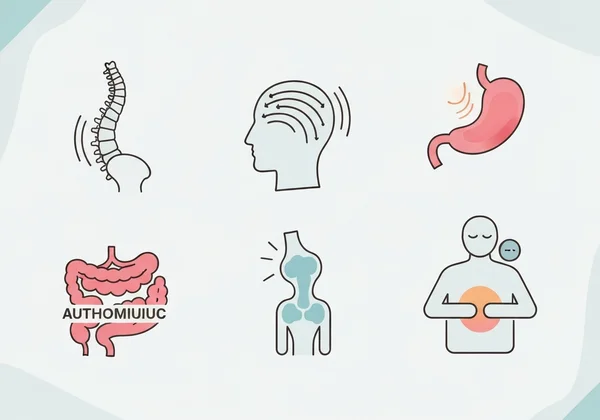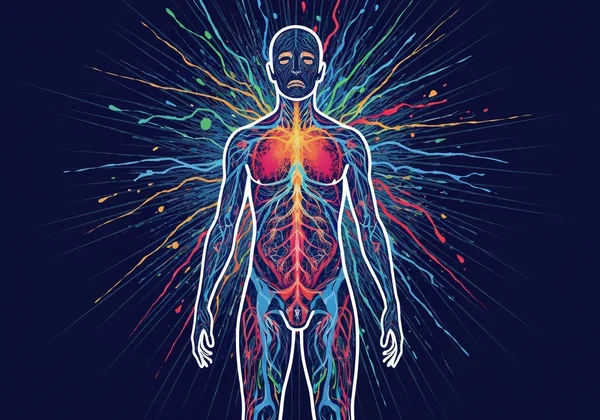Unexplained Aches? How a Trauma Test Can Reveal Physical Symptoms of Trauma
Do you live with unexplained aches, persistent fatigue, or digestive problems that doctors can't seem to solve? You are not alone, and your pain is real. Many people don't realize that the body keeps a detailed record of our life experiences, especially the difficult ones. This article explores the powerful and undeniable link between your mind and body, revealing how the physical symptoms of trauma can show up long after an event has passed. How do I know if I have trauma? For many, the first clues are not in memories, but in physical sensations—clues that an online trauma test can help you begin to decipher.
Understanding that your body might be holding onto unresolved emotional pain is a crucial first step toward healing. It validates your experience and opens the door to relief. By exploring this connection, you can begin a journey of self-discovery and find tools that can help. A great place to start is with a confidential online trauma test that can offer preliminary insights into your symptoms.

Understanding Somatic Trauma Symptoms
When we talk about physical symptoms rooted in emotional distress, we often use the term "somatic." Somatic symptoms are real physical sensations that originate from psychological or emotional stress. It's the body's way of speaking when words are not enough. Instead of being "all in your head," these symptoms are very much in your body, driven by a nervous system trying to process overwhelming experiences.
This is not a sign of weakness; it is a testament to your body's attempt to survive. Recognizing these signals is a compassionate act of self-awareness. It allows you to shift from asking "What is wrong with me?" to "What has happened to me, and how can I support my body through it?" This is precisely the kind of insight a preliminary PTSD test can help uncover.
What Are the Physical Manifestations of Unresolved Trauma?
Unresolved trauma doesn't just fade away; it can become embedded in our physiology. The constant state of high alert that follows a traumatic experience keeps the body flooded with stress hormones like cortisol and adrenaline. Over time, this chronic stress can lead to a wide range of physical issues.
These manifestations are the body's distress signals. They can include a constant feeling of being on edge, an exaggerated startle response, difficulty sleeping, or a sense of bodily tension you can't seem to release. These are not random occurrences; they are often direct echoes of the body's attempt to protect itself during a past event. By learning to listen to these signals, you can begin to understand your body's story.
Common Physical Ailments Linked to Trauma
The link between trauma and chronic pain is well-documented. If you've been searching for answers to persistent health issues without success, it may be helpful to consider the potential influence of past experiences. Some of the most common physical ailments linked to trauma include:
-
Chronic Pain: Unexplained back pain, neck tension, fibromyalgia, and pelvic pain can be connected to the body holding onto the tension of a fight-or-flight response.
-
Migraines and Headaches: Chronic stress and hypervigilance can lead to tension headaches and trigger debilitating migraines.
-
Digestive Issues: The gut is often called the "second brain." Trauma can disrupt the delicate balance of the gut microbiome, leading to conditions like Irritable Bowel Syndrome (IBS), acid reflux, and food sensitivities.
-
Autoimmune Disorders: While the connection is still being researched, prolonged stress from trauma is believed to contribute to the inflammation that can trigger autoimmune conditions like rheumatoid arthritis or lupus.
-
Chronic Fatigue: Feeling perpetually exhausted, no matter how much you sleep, is a hallmark of a nervous system that is stuck in survival mode. It's working overtime, even when you are at rest.

Trauma Stored in the Body: The Nervous System's Role
To truly understand why trauma causes physical pain, we must look at the nervous system. Our autonomic nervous system is designed to keep us safe. When it perceives a threat, it instantly activates a survival response. The concept of trauma stored in the body refers to what happens when this survival energy doesn't get a chance to resolve and release after the danger has passed.
Instead, it remains trapped, leaving the nervous system in a state of dysregulation. This dysregulation is what fuels many of the chronic physical symptoms people experience. Your body is still trying to fight a battle that, in the present moment, is over. Healing involves gently teaching your nervous system that it is safe now. The first step is often gaining clarity, which an initial trauma response test can help provide.

How Fight, Flight, Freeze Responses Impact Your Physiology
Our primary trauma responses are instinctual and not under our conscious control. Understanding them can help you feel less shame and more compassion for your body's reactions.
- Fight: The body prepares for confrontation. Adrenaline surges, muscles tense, and the heart rate skyrockets. If this energy is not discharged, it can lead to chronic muscle tension, anger, and irritability.
- Flight: The body prepares to escape. Blood is diverted to the large muscles, and you may feel restless or anxious. When stuck in this state, it can manifest as anxiety, panic attacks, and an inability to relax.
- Freeze: This happens when fighting or fleeing is not an option. The body immobilizes, almost like playing dead. Physiologically, it involves a complex mix of high arousal and shutdown. Long-term, this can lead to feelings of numbness, disconnection (dissociation), and chronic fatigue.
The Link Between Chronic Stress, Trauma, and Inflammation
When the body is perpetually stuck in a survival state, it produces an excess of stress hormones. This sustained hormonal bath leads to chronic inflammation, which is a key driver of many modern diseases. Inflammation is the body's natural response to injury, but when it becomes chronic, it starts to damage healthy tissues.
This systemic inflammation can contribute to heart disease, diabetes, and the chronic pain conditions mentioned earlier. It explains why trauma isn't just an emotional issue—it is a full-body experience with profound and lasting physiological consequences. Addressing the root cause—the unresolved trauma—is therefore essential for long-term physical health.
Connecting the Dots: When to Consider Trauma as a Cause
If you have been struggling with persistent physical symptoms and medical tests have come back inconclusive, it may be time to consider the role of trauma. This is about expanding your understanding of health, not dismissing medical advice. Your pain is valid, and exploring its potential roots in your life experiences can be an empowering step toward finding effective relief.
Recognizing Patterns: Beyond Medical Explanations
Start to gently observe your body. Do your symptoms flare up during times of stress, around certain anniversaries, or when you interact with specific people? Noticing these patterns is a powerful way to connect the dots between your emotional state and your physical well-being. Keeping a simple journal can help you identify triggers you may not have been aware of. This isn't about blaming yourself; it's about gathering information to better care for yourself.
Taking the First Step: The Role of Self-Assessment
For many, the idea that their physical pain could be linked to past trauma is a new and overwhelming concept. A gentle, private, and structured way to begin exploring this connection is through a self-assessment. The free psychological trauma test available on our website is designed to help you identify potential trauma-related symptoms in a safe and confidential way. It is not a diagnosis, but a tool for insight—a first step in validating your body's story and illuminating a path forward. Start your self-assessment today to gain a deeper understanding.

Towards Healing: Validating Your Body's Story
Your body has been trying to communicate with you. The aches, the fatigue, and the pain are not signs of failure but signals of a story that needs to be heard. Understanding the physical symptoms of trauma is the beginning of a healing journey that integrates both mind and body. It's about learning to listen with compassion, honoring your body's wisdom, and recognizing that you have the capacity to heal.
This journey starts with a single step: awareness. We invite you to continue your exploration safely and privately. Visit our website to use our free, confidential screening tool. It can provide the clarity you need to move forward toward a life with less pain and more peace.
FAQ Section
How do I know if my physical pain is related to trauma?
While only a healthcare professional can provide a diagnosis, you can look for patterns. Notice if your physical symptoms worsen with emotional stress, memories, or specific situations. If extensive medical tests have not found a cause for your chronic pain, fatigue, or digestive issues, it is a valid and important step to consider the potential role of unresolved trauma. Taking a free trauma test can be an insightful first step in this exploration.
What does unresolved trauma look like physically?
Physically, unresolved trauma can manifest in many ways. Common signs include chronic muscle tension (especially in the jaw, neck, and shoulders), persistent fatigue that isn't relieved by sleep, digestive problems like IBS, frequent headaches or migraines, and a heightened startle response. It can also contribute to autoimmune conditions and fibromyalgia.
Can you self-diagnose trauma based on physical symptoms alone?
No, you cannot self-diagnose trauma. Trauma is a complex condition, and a formal diagnosis like PTSD can only be made by a qualified mental health professional. However, recognizing that your physical symptoms could be linked to trauma is a crucial step in seeking the right kind of help. Online screening tools are designed to provide preliminary insights, not a diagnosis. They can help you decide if it's time to speak with a professional.
What is the most accurate way to assess for potential trauma?
The most accurate way is a comprehensive evaluation by a trauma-informed therapist or psychologist. However, a high-quality, scientifically-designed online trauma test can be an excellent and highly accurate first step. The preliminary screening tool on our website is designed to help you privately assess your symptoms and provides a solid foundation for a more informed conversation with a healthcare provider.
How can I begin to heal from childhood trauma and its physical effects?
Healing begins with acknowledging the connection between your past experiences and your present physical symptoms. The first step is often education and self-awareness. Using a tool like a childhood trauma test can provide validation and clarity. The next steps typically involve seeking support from a trauma-informed therapist who can help you process experiences and learn techniques (like grounding and somatic exercises) to regulate your nervous system and relieve physical tension.